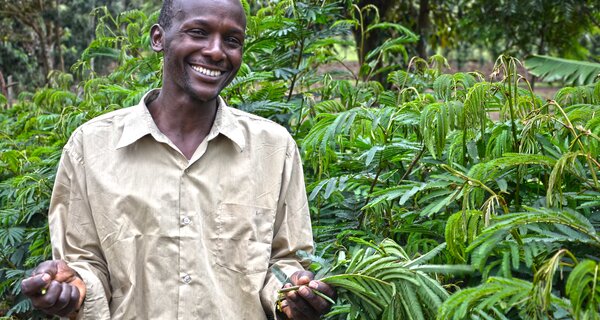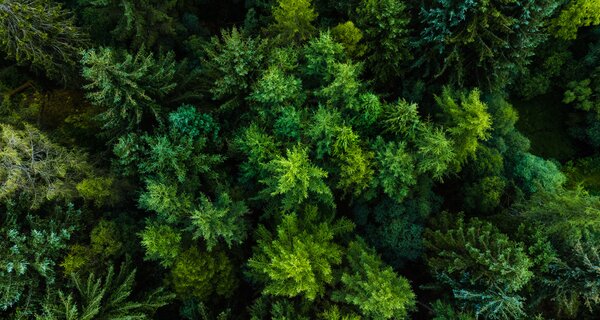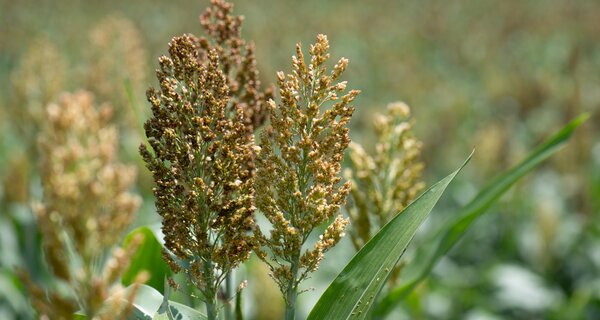Cracking the Problem of Tree Seeds
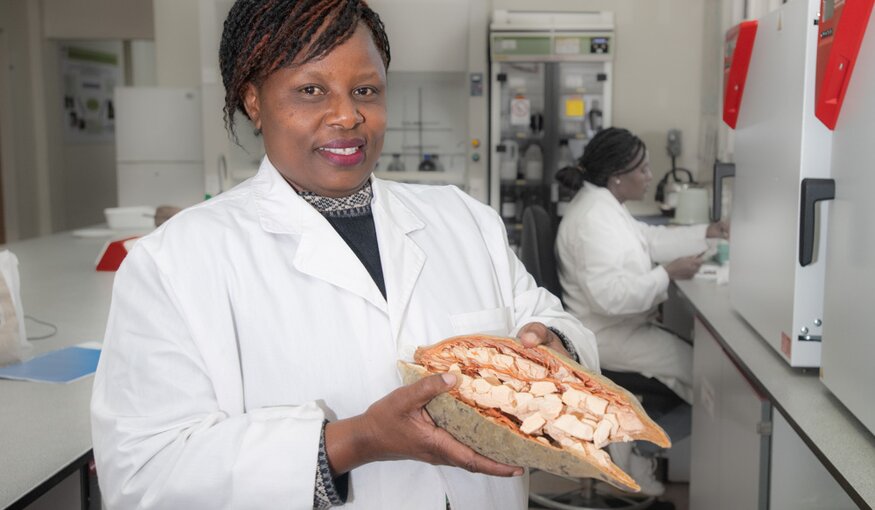
The seeds of the baobab are covered with a whitish-pink, dry, acidic pulp that is high in Vitamin C and makes a nice juice. Agnes Were, a laboratory assistant at ICRAF’s genebank in Nairobi displays an open baobab fruit. The seeds are soaked in water to remove the pulp. Photo: Michael Major/Crop Trust
4 April 2023
World Agroforestry’s (ICRAF) genebank hosts the world’s largest holdings of agroforestry tree genetic resources but encounters several unique challenges in getting some of the seeds in its collection of 190 species to germinate.
BANG! BANG! BANG! People walking past the genebank of World Agroforestry (ICRAF) may need to block their ears when the technicians are opening a baobab fruit. Agnes Were, a laboratory assistant, wields a hammer to open the hard, woody exterior and reveal the fibrous seeds inside. BANG! BANG! BANG! A hammer works for the baobab, but that is just one of many tools and techniques that ICRAF genebank staff have developed to bring tree species into ex situ conservation.
“As a genebank for trees, we encounter several unique challenges,” said Alice Muchugi, the former manager of ICRAF’s Genetic Resources Unit (GRU). “Some of the normally routine genebank operations like regeneration are a major undertaking since trees take years to mature. And maintaining the integrity of an accession is difficult, as tropical trees are predominantly outcrossing. Seed germination is also an issue. The seed of each species has its own characteristics and there is limited information on most of them. Therefore, we need to carry out research on how best to unlock the seeds of each species and get them to germinate.”
The ICRAF genebank was established in 1997 and now hosts the world’s largest holdings of agroforestry tree genetic resources. ICRAF has a medium-term storage facility in Nairobi which safeguards more than 6,000 seed accessions of 190 species. Another 17,000 accessions of more than 681 species are in 49 field genebanks located in 18 countries in Africa, Latin America and Asia. The accessions are primarily indigenous tree species useful for many different purposes as sources of medicinal extract, fruit, fodder, vegetables, specialist woods and timber. The diverse tree species also help in improving soil nutrient content, retaining water and providing shade. By conserving and making available the best specimens of these tree species, ICRAF helps farmers and other landowners to plant more trees.
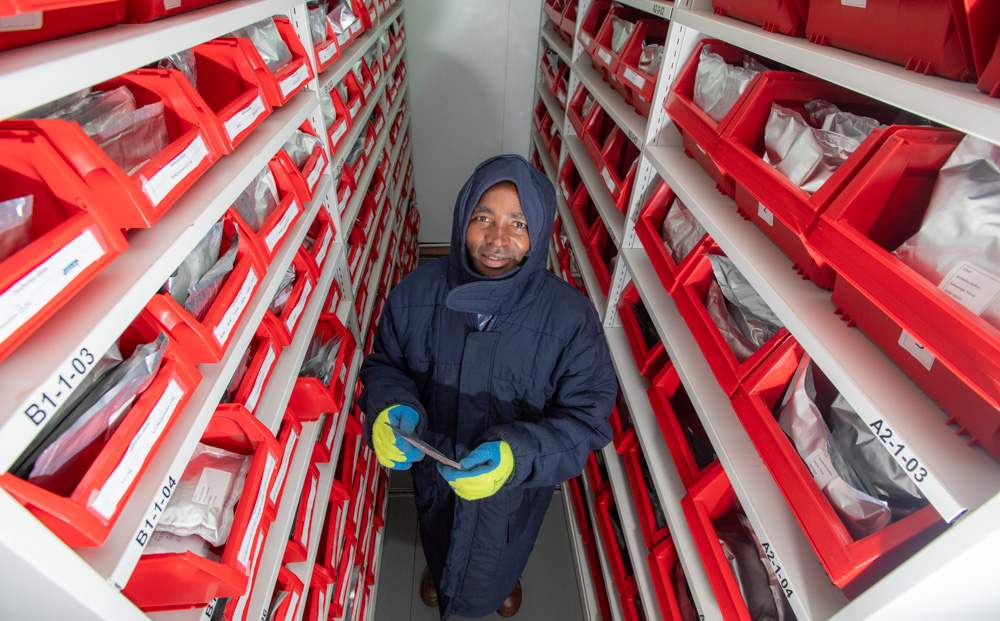
The ICRAF genebank maintains a medium-term cold storage facility at 5°C and 15% RH that holds the active collection at ICRAF’s headquarters in Nairobi. Zakayo Kinyanjui, (pictured here) says the active collection currently stands at slightly over 5,300 accessions. Photo: Michael Major/Crop Trust
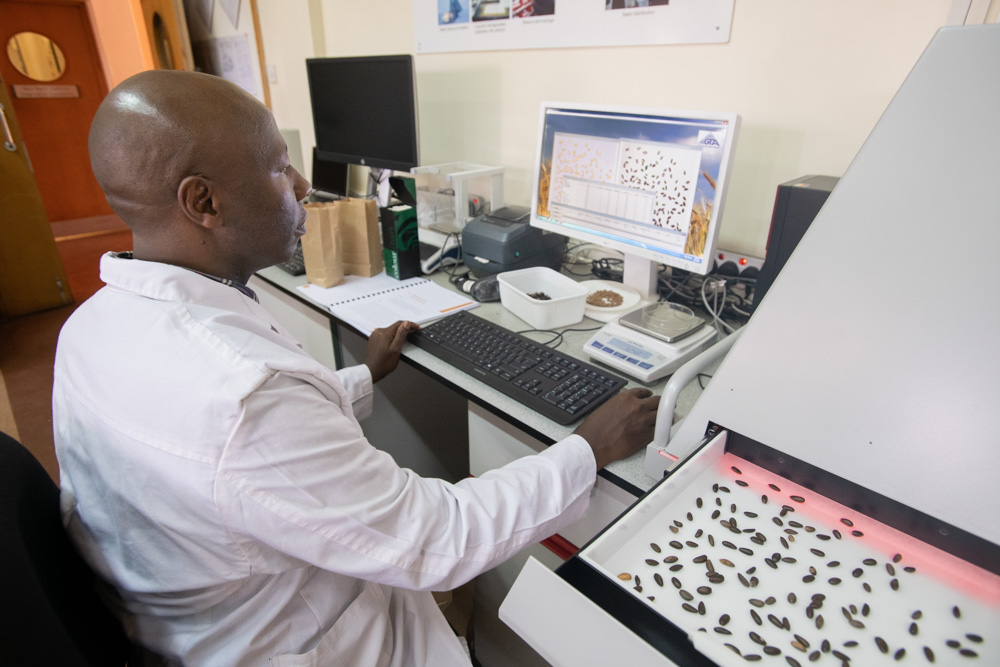
Simon Kang’ethe, genebank database officer, conducts seed characterization of Annona squamosa using the Marvin5 seed analyser. The Marvin5 helps genebank staff to count and measure (length, width and shape) seeds quickly. Photo: Michael Major/Crop Trust
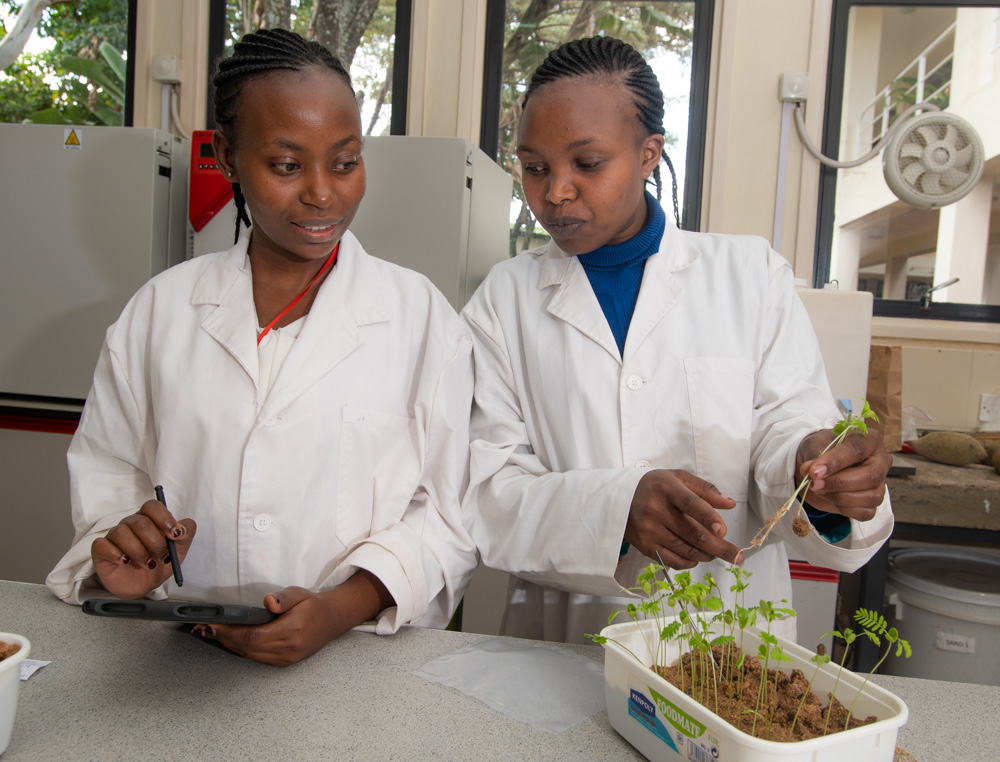
Eliza King’ori (left), an intern, and Ludy Keino, a laboratory technician at ICRAF, evaluate germination of Albizia odoratissima seedlings. Called black siris in India, the tree fixes nitrogen and is valuable for fodder, fuel and timber. Photo: Michael Major/Crop Trust
Challenges
“Trees are totally different from annual food crops, so the general model presented by crop genebanks for seed management and ex situ conservation doesn’t always apply to us,” revealed Alice. “The large number of genera, long regeneration intervals, large growth forms, generally outbreeding reproductive systems and species-specific seed storage and regeneration requirements of agroforestry trees require a more complex, and more flexible, approach.”
Many tree species, for example, have so-called recalcitrant seeds – seeds that cannot be dried and stored at low temperature the way cereal seeds, for example, can. These species thus need to be maintained as living plants in field genebanks.
“We need to promote decentralized and complementary conservation methods,” she noted. “This could include seed genebanks, live ex situ field genebanks, conservation circa situ, which means in farmland around natural forest, and in situ, which is in the wild and on farm.”
Ex situ seed storage is the most common conservation method for orthodox seeds like cereals – seeds that can be dried and stored at low temperature. However, if the species is popular and the seed is demanded by users, then eventually more seed has to be produced. For trees, this is expensive and difficult, demanding not only customized germination protocols for each species but a large amount of space and time to keep the trees until they mature and bear fruit.
“We have to conduct a fair bit of research to establish dormancy-breaking techniques for many species before we can get them to germinate,” Alice reiterates. “We also have to keep monitoring their viability in storage because no one has really kept tropical tree seed on this scale or for this long before, and we don’t know how many years all the different species will keep their viability in these storage conditions.”
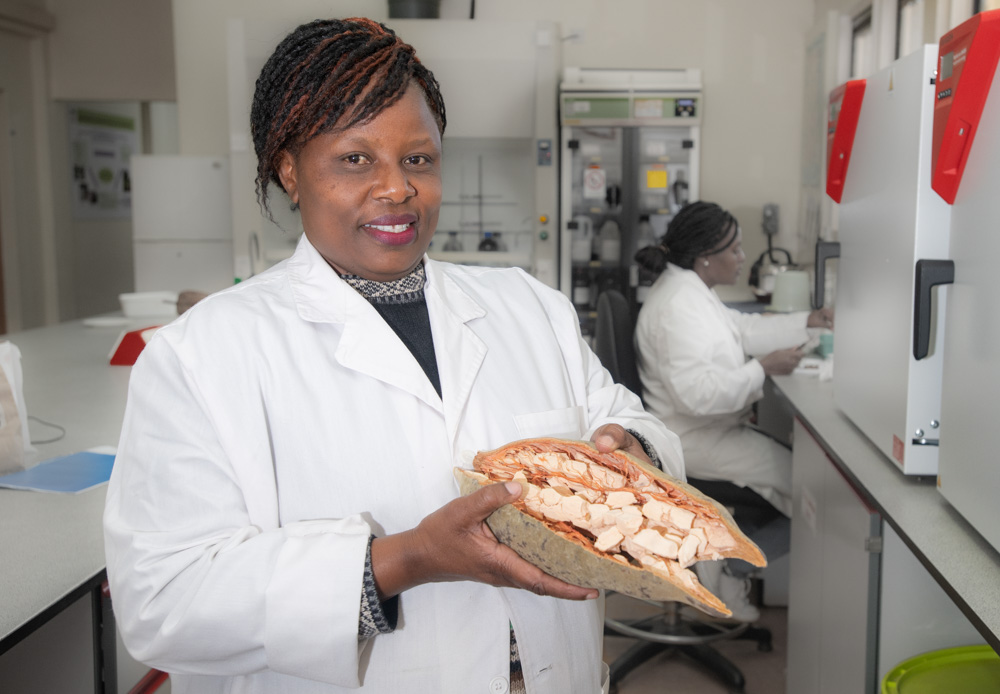
The seeds of the baobab are covered with a whitish-pink, dry, acidic pulp that is high in Vitamin C and makes a nice juice. Agnes Were, a laboratory assistant at ICRAF’s genebank in Nairobi displays an open baobab fruit. The seeds are soaked in water to remove the pulp. Photo: Michael Major/Crop Trust
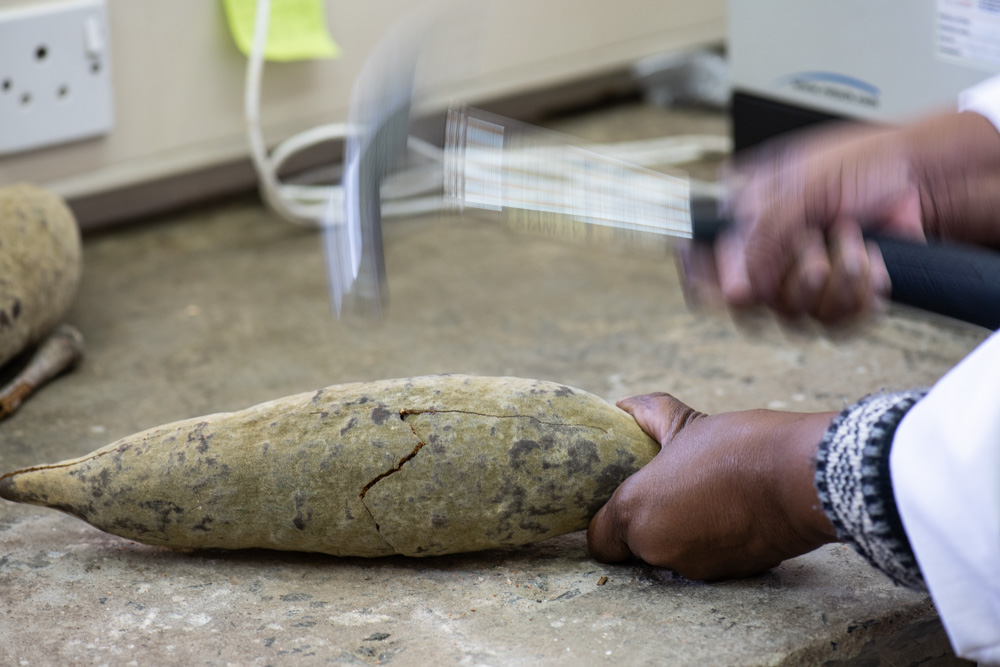
Adansonia digitata, commonly known as the baobab, is native to the drier parts of Africa. Baobabs have traditionally been valued as sources of food, water, health remedies and places of shelter and are steeped in legend and superstition. The ICRAF genebank holds 180 accessions of Adansonia. The fruit of the baobab is variable and has a hard woody shell which must be cracked with a hard blow by a hammer to extract the seed. Each fruit can contain up to 100 seeds. Photo: Michael Major/Crop Trust
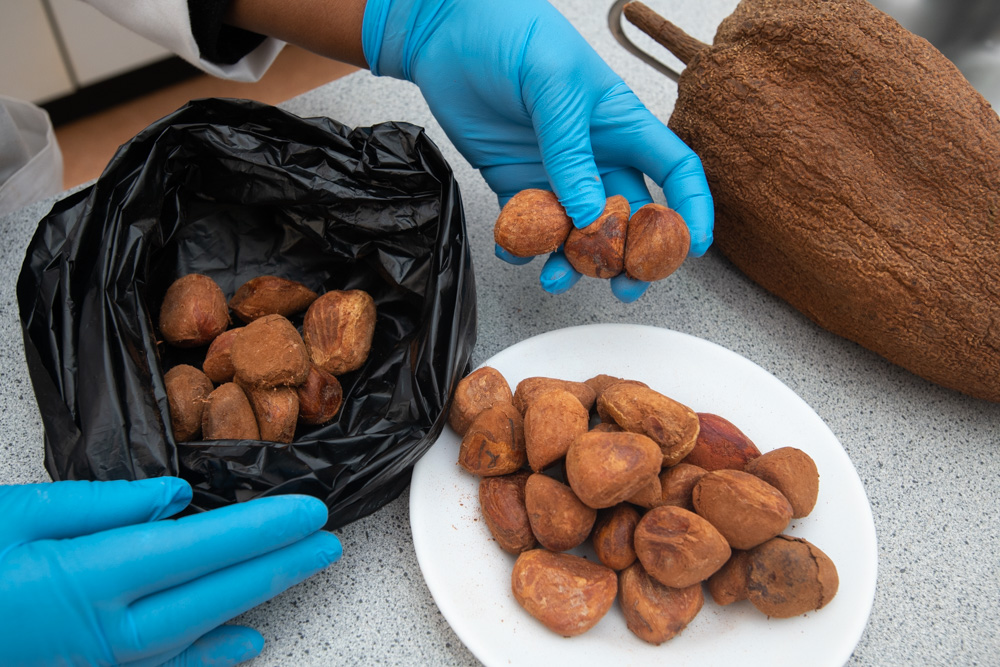
Allanblackia germination: ICRAF staff initially encountered challenges, but after some trial and error, they discovered that the seeds would germinate if stored in black plastic bags. Photo: Michael Major/Crop Trust
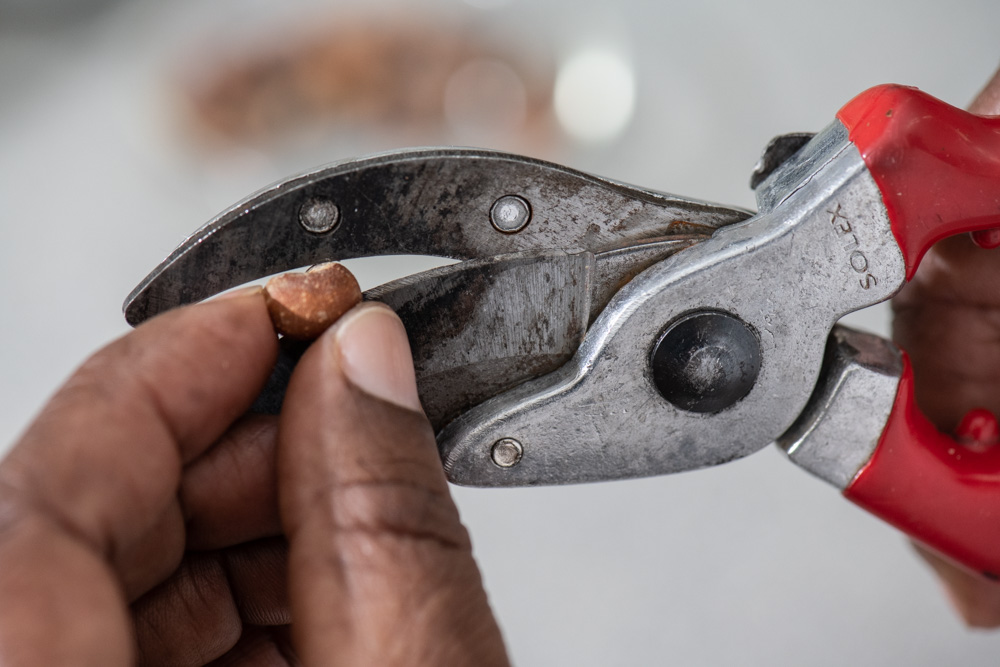
The final step in the preparation of Adansonia digitata is to nip the seed using secateurs. Photo: Michael Major/Crop Trust
Nature and Local Knowledge Help Solve The Allanblackia challenge
Allanblackia is a good example of how ICRAF had to learn about breaking dormancy. This species is a native African tree that has been valued for centuries for its oil. It’s often called the tallow tree. In 2000, Unilever discovered what local villagers had known for generations: the oil is a food technologist’s dream and is ideally suited for spreads like margarine. In 2004, Unilever began working with ICRAF to domesticate Allanblackia, but soon realized that getting the seed to germinate was no easy task.
“We tried the conventional approaches, like nipping, soaking in water and treating with chemicals to break seed dormancy,” said Alice. “Those approaches were unsuccessful, so we started looking both to nature and local knowledge and applied a lot of trial and error in our search for a solution.”
Some communities in Tanzania shared their knowledge and experiences on seed germination with the ICRAF researchers. “They noted that seeds that had been buried by giant rats and forgotten would germinate. So, we decided to mimic the process.”
Following these ideas and taking the example of another lucky experience led to an effective method. “A farmer in Ghana told us that he had stored some seeds in a black polyethylene bag. When he opened the bag a few weeks later, he discovered that the seeds had germinated.”
“We replicated the black polyethylene bag method in the genebank and finally succeeded in breaking dormancy and starting germination after about four weeks,” Alice explained.
Establishing Standard Operating Procedures
Understanding the biology of the lesser-known tree species has been a challenge for ICRAF’s genebank staff, but once they determine the best techniques to break dormancy the procedures are documented. “We have worked with the CGIAR Genebank Platform to document our protocols as standard operating procedures, which we refer to as SOPs,” said Zakayo Kinyanjui, the GRU’s Seed Physiologist. “SOPs ensure that all protocols are conducted consistently now and in the future. With so many types of seed to process, we’d be lost without our SOP documents.”
The ICRAF team has developed SOPs for seed acquisition, conservation, characterization and distribution with assistance from Janny van Beem, the quality management specialist working with the Crop Trust. “An audit system is currently in place to ensure that all SOPs adhere to relevant standards, policies and best practices,” said Janny. “ICRAF’s genebank is quite distinct from other genebanks so it is critical to get these procedures documented and audited.”
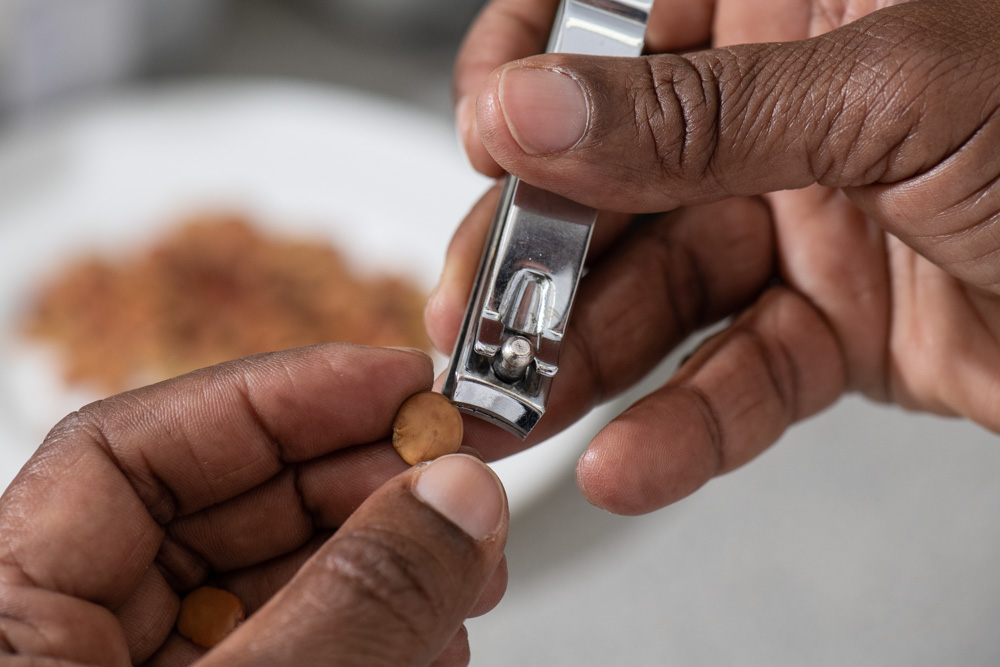
Gliricidia sepium, native to Mexico and Central America, is the quintessential multipurpose tree. It is highly suitable in agroforestry systems due to its nitrogen-fixing properties and leaves that can be used for mulch and green manure. It is probably the most common living fence species in the tropics. The ICRAF genebank holds about 215 accessions of Gliricidia sourced mainly from its native region. In order to promote germination, the seed must be nipped using a nail cutter. Photo: Michael Major/Crop Trust
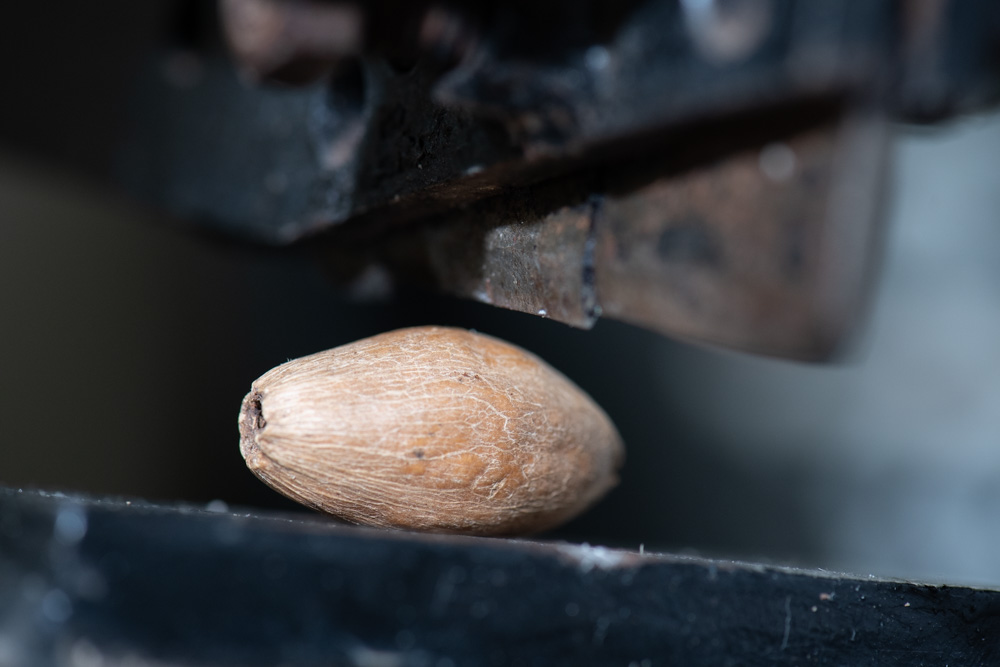
The Melia volkensii (melia or tree of knowledge), is native to East Africa and is used for timber and fodder. The wood is easily worked and shaped, making it suitable for making acoustic drums, containers and mortars. Farmers believe leaf fodder is of high quality for both cattle and goats. The tree comes into leaf and is pruned for fodder towards the end of the dry season, a time when fodder is extremely scarce. ICRAF lists 25 accessions of M. volkensii on Genesys. Staff extract the seed using a custom-made vice. Photo: Michael Major/Crop Trust
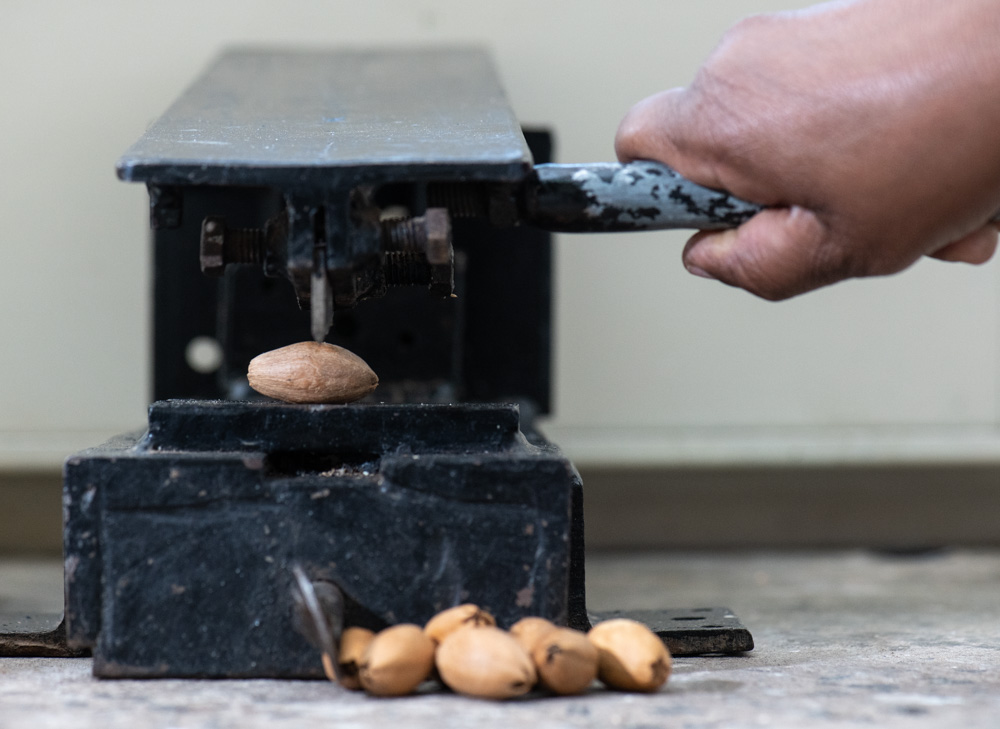
Extraction of Melia volkensii seed on a custom-made vice. Photo: Michael Major/Crop Trust
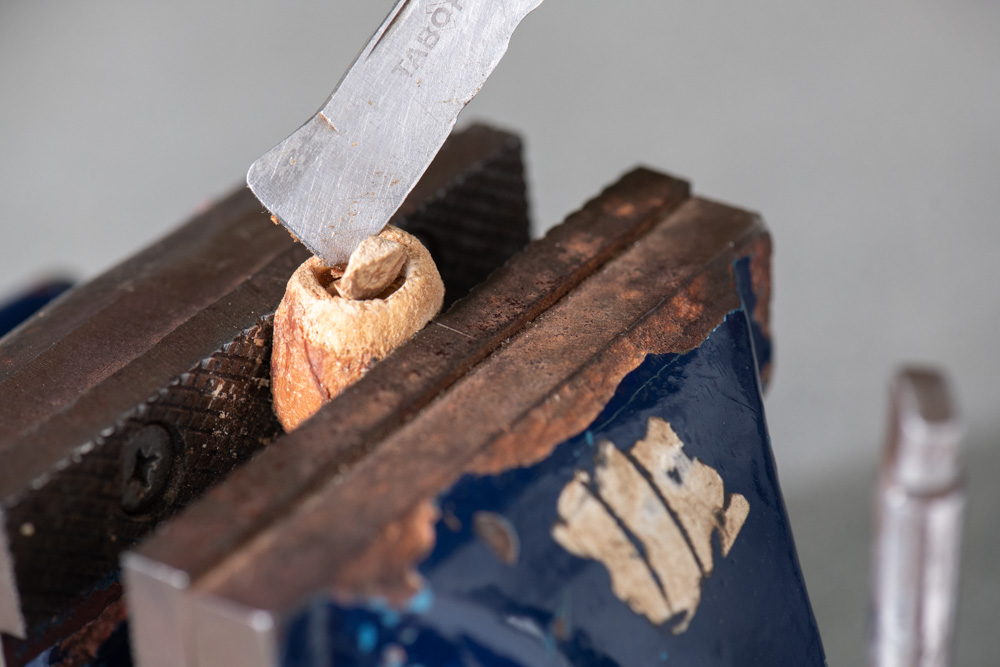
Extraction of Melia volkensii seed on a custom-made vice. Photo: Michael Major/Crop Trust
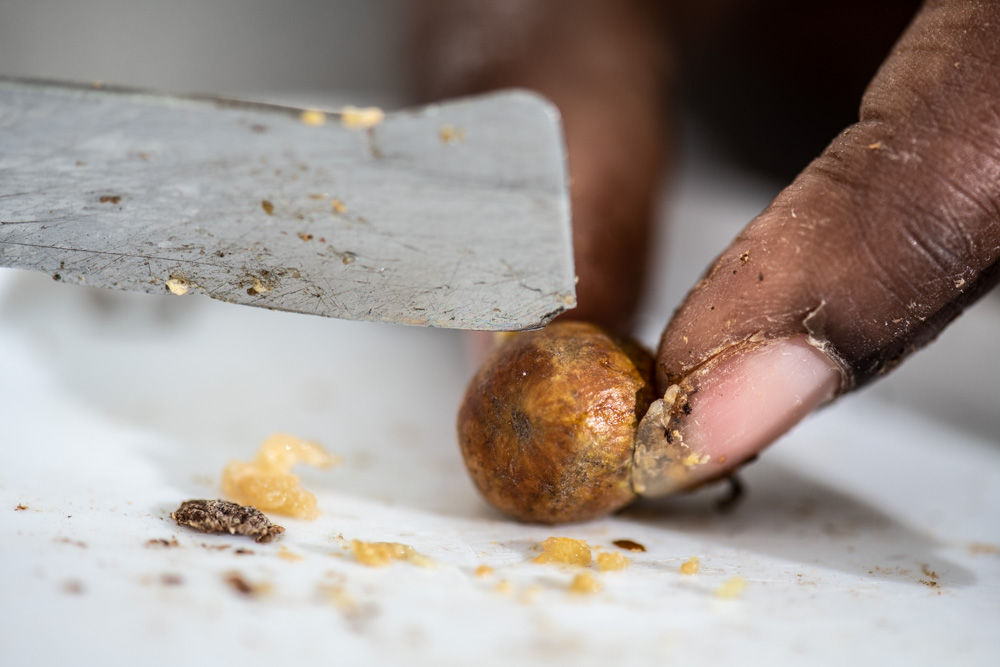
Ziziphus jujuba (jujube) is native to South and Central Asia and China and is a multipurpose tree that provides fruit, fodder and fuel. The fruits are usually eaten fresh; they have high vitamin C content and are very nutritious. The timber is hard and is used for a number of purposes where a durable, close-grained wood is needed. A genebank removes the pulp from the seeds. Photo: Michael Major/Crop Trust
Kick-starting Germination
Written procedures are critical when you have such a diversity of material. Eucalyptus species have seeds of less than one millimeter in diameter, while the Allanblackia fruit can weigh 5 kg or more. With most species, genebank staff can puncture the seed coat [to allow water to get in and germinate the seed] with a razor blade, scalpel or emery paper without damaging the embryo. However, some tree species have very hard seed cases that are impossible to scarify using normal abrasion techniques. So, over the years, staff at ICRAF have developed numerous distinct protocols for the varied species in their collection.
The ICRAF genebank has more tools than a medieval torture chamber, with hammers, saws, vices, garden secateurs, fingernail clippers and more. For some species, only a few seeds are collected, so any seeds used in germination tests are grown out and taken to the field nursery for research or distribution.
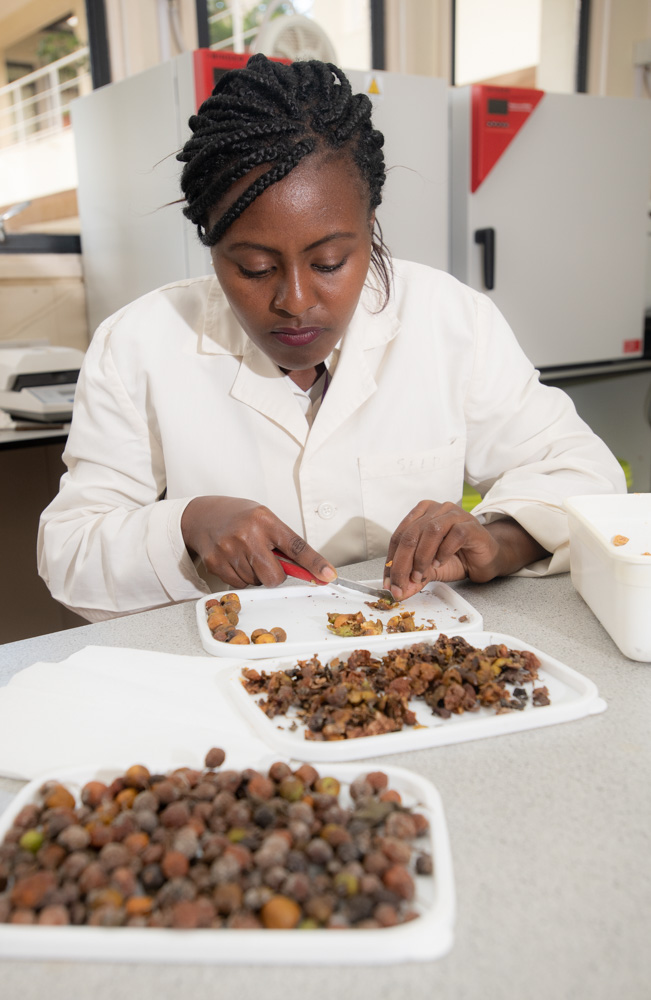
Ziziphus jujuba (jujube) is native to South and Central Asia and China and is a multipurpose tree that provides fruit, fodder and fuel. The fruits are usually eaten fresh; they have high vitamin C content and are very nutritious. The timber is hard and is used for a number of purposes where a durable, close-grained wood is needed. Shelmith Wangechi, a genebank intern at the ICRAF genebank in Nairobi, is seen here removing the pulp from the seeds. Photo: Michael Major/Crop Trust
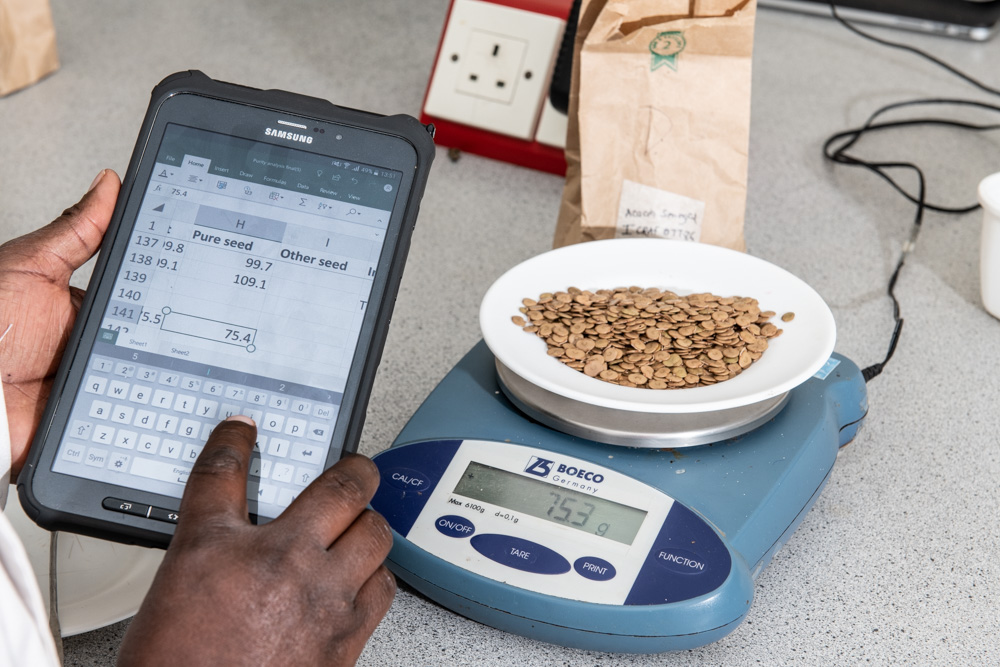
Performing purity analysis of Acacia senegal or gum arabic. This drought tolerant native of Africa is well known for its resin which is used in the food industry as a stabilizer. Photo: Michael Major/Crop Trust
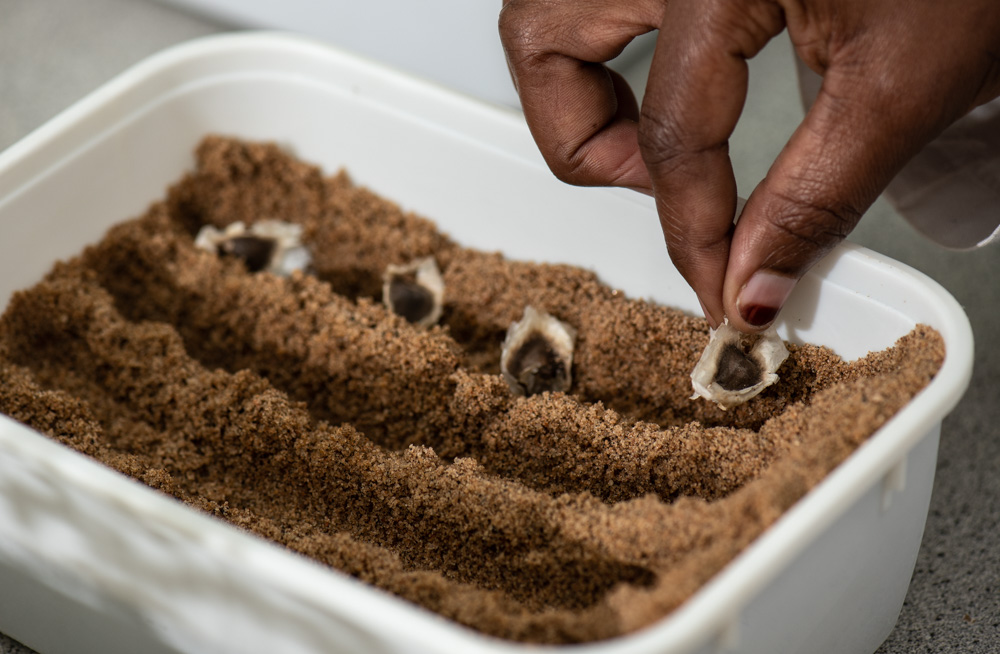
Germination planting of Moringa oleifera or drumstick tree in English on sand. The leaves of ‘M. oleifera’ are a good source of protein, vitamins A, B and C and minerals such as calcium and iron, are used as a spinach equivalent. They are an excellent source of the sulphur-containing amino acids methionine and cystine, which are often in short supply. Moringa seeds are effective against skin-infecting bacteria Staphylococcus aureus and Pseudomonas aeruginosa. They contain the potent antibiotic and fungicide terygospermin. Photo: Michael Major/Crop Trust
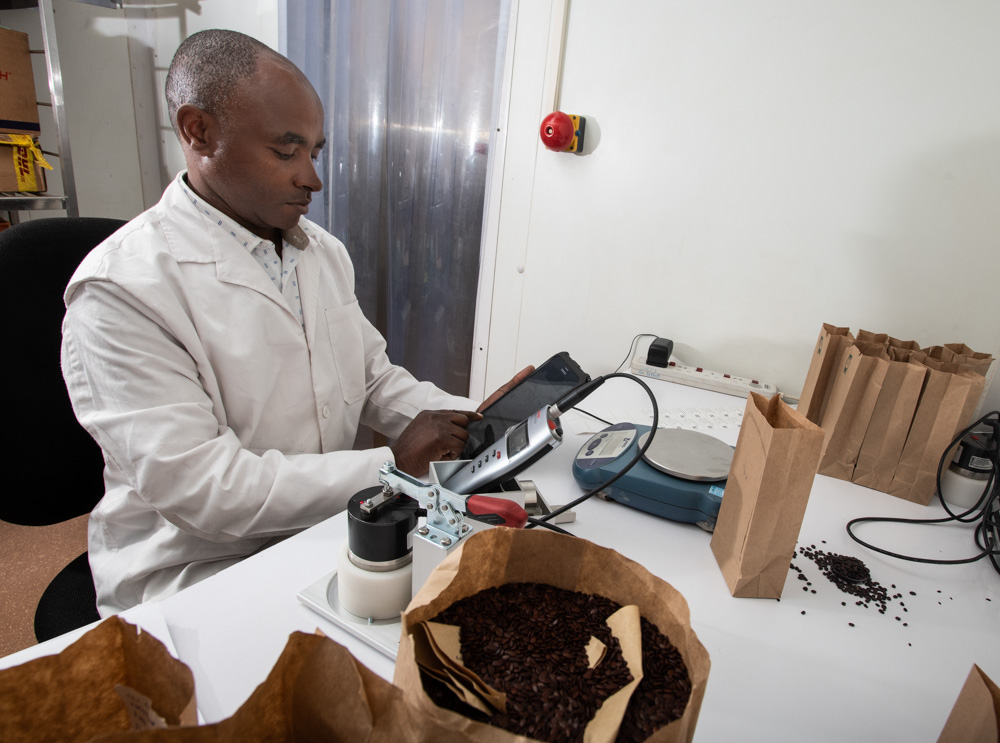
Zakayo Kinyanjui, a seed physiologist, measures the moisture content of Leucaena trichandra seed before storage. Known in Spanish as guaje rojo, L. trichandra is a small understorey or lower canopy tree native to Mexico and Central America. Like many agroforestry species, it has multiple uses for food, fodder, timber, fuel and shade. ICRAF has 124 accessions listed on Genesys. Photo: Michael Major/Crop Trust
Multiplying for Distribution
All this expertise in conservation techniques is fantastic for keeping the seeds healthy in storage for the long term. However, the demand for tree seed from ICRAF is increasing. In 2021 alone, ICRAF sent germplasm samples to 3,061 users around the world not including ICRAF’s own users. About 98% of those samples went directly to farmers. “Other genebank materials may first pass through a breeding pipeline before they turn up as improved varieties in farmers’ fields, but most trees are not yet domesticated so our users tend to be the farmers themselves,” said Alice.
ICRAF’s germplasm recipients can be divided into two main groups. Farmers may request the seeds for their own use. They raise the seeds in their nurseries and plant the trees on their farms. Alternatively, community-based organizations request material and then distribute to farmers. “These are mainly smallholder farmers who in the end may plant 5-10 trees of a species on their farms,” said Alice.
“If funds are available, we may monitor the performance of the distributed material in the farmers’ fields,” said Alice. Tree germplasm research projects tend to be very participatory. Trees require a lot of space and take years to mature. Most research centers do not have that much land available so most of the research is conducted on farmers’ fields.
Safeguarding Tree Diversity Forever
Trees play a vital role in many agricultural systems and are key to climate change mitigation. By safeguarding their diversity, we improve our food security and our ability to adapt to our changing climate. ICRAF’s genebank has been cracking the problem of tree seed conservation for more than 25 years to ensure that farmers continue to have access to tree diversity. By distributing thousands of tree seeds and cuttings every year, the ICRAF genebank is paving the way to a future filled with trees.
This story originally appeared on the website of the CGIAR Genebank Platform
Categories: Genebank Platform, Genebanks, Agroforestry Trees
The CGIAR Genebank Platform
This article was originally published by the CGIAR Genebank Platform, a project which ran from 2017 to the end of 2021. It enabled CGIAR Research Centers to fulfill their legal obligation to conserve and make available 750,000 seed samples of crops and trees on behalf of the global community under the International Treaty on Plant Genetic Resources for Food and Agriculture. The Platform supported day-to-day genebank operations, and activities to improve efficiency, enhance use and ensure compliance with international policy. This work was supported jointly by donor contributions to the CGIAR Fund and the Crop Trust Endowment Fund.


